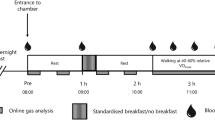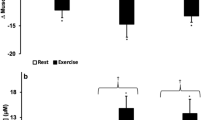Abstract
Adams and Cain (1983) found that non-muscle regions of the body decreased their share of excess post-hypoxic oxygen uptake (\(\dot VO\)O2) with longer periods of hypoxia. They suggested that part of non-muscle \(\dot VO\)O2 was not obligated for energy production. Mortillaro and Granger (1977) showed that intestine followed a similar pattern of excess \(\dot VO\)O2 when arterial occlusion created an O2 deficit. Shepherd (1978) showed that an arterial PO2 of 46 Torr decreased intestinal \(\dot VO\)O2 26% but, in contrast, hindlimb \(\dot VO\)O2 was unaffected by an arterial PO2 of 36 Torr (Cain & Chapler, 1979) while, at the same time, whole body \(\dot VO\)O2 was decreased approximately 12%. These data, and the fact that gut \(\dot VO\)O2 is 20–25% that of whole body, even though intestine accounts for <5% of body weight, implicated gut as a bigger contributor of O2 excess used in recovery. Since Shepherd (1978) did not measure \(\dot VO\)O2 during recovery and Mortillaro and Granger (1977) did not use hypoxia, there was no information on the intestinal O2 deficit/excess relationship during and after hypoxia. In addition, its contribution to whole body O2 deficit/excess remained in question. Thus, the purposes of these experiments were to 1) measure the gut O2 deficit/excess relationship during acute hypoxic hypoxia, 2) determine the contribution of gut in whole body O2 deficit and excess and 3) ascertain the means by which intestine copes with acute bouts of hypoxic hypoxia.
This study was supported by grant #HL-26927, National Heart, Lung and Blood Institute.
Access this chapter
Tax calculation will be finalised at checkout
Purchases are for personal use only
Preview
Unable to display preview. Download preview PDF.
Similar content being viewed by others
References
Adams, R.P., and Cain, S.M., 1983, Total and hindlimb oxygen deficit and “repayment” in hypoxic anesthetized dogs. J. Appl.. Physiol.: Respirat. Environ. Exercise Physiol. 55(3):913–922.
Bohlen, 11.G., 1984, Tissue oxygenation and splanchnic bleed flow, in: Physiology of the Intestinal Circulation,“ A.P. Shepherd and D.N. Granger, eds., Raven Press, New York.
Cain, S.M., 1969, Diminution of lactate rise during hypoxia by PO2 and beta-adrenergic blockade, Am. J. Physiol. 217:10C-116.
Cain, S.M. and Chapler, C.K., 1979, Oxygen extraction by canine hindlimb during hypoxie hypoxia, J. Appl. Physiol.: Respirat. Environ. Exercise Physiol. 46:1023–1028.
Chou, C.C. and Gallavan, R.H., 1982, Blood flow and intestinal motility, Fed. Proc. 41:2090–2095.
Durotoye, A.O., and Grayson, J., 1971, Heat production in the gastrointestinal tract of the dog, J. Physiol., 214: 417–426.
Grayson, J., and Oyebola, D.D.O., 1983, The effect of catecholamines on intestinal glucose and oxygen uptake in the dog. J. Physiol. 343:311–322.
Greenway, C.V., 1984, Neural control and autoregulatory escape, in: “Physiology in the Intestinal Circulation,” A.P. Shepherd and D.N.Granger, eds., Raven Press, New York.
Kintner, D., Fitzpatrick, J.H., Louie, J.A., and Gilboe, D.D., 1984, Cerebral oxygen and energy metabolism during and after 30 minutes of moderate hypoxia, Am. J. Physiol. 247(10):E475–E482.
Kvietys, P.R., Perry, M.A. and Cranger, D.N., 1983, Intestinal capillary exchange capacity and oxygen delivery-to-demand ratio, Am. J. Physiol. 245(8):G635–C640.
Kvietys, P.R., Harper, S.L., Korthuis, R.J. and Granger, D.N., 1985, Effects of temperature on oleal blood flow and oxygenation, Fed. Proc. 44 (3): 446.
Meissner, A., Bowes, K.L. and Sarna, S.K., 1976, Effects of ambient and stagnant hypoxia on the mechanical and electrical activity of the canine upper jejunum, Can. J. Surg. 19:316–321.
Mortillaro, N.A., and Granger, H.J., Reactive Hyperemia and oxygen extraction in the feline small intestine, Circ. Res., 41: 859–865.
Nylander, G., and Wikstrom, S.. 1968, Propulsive gastrointestinal motility in regional and graded ischemia of the small bowel. An Experimental study in rats. I. Immediate results., Acta Chir. Scand. (Suppl.), 385:1–67.
Perry, M.A., Shepherd, A.P., Kvietys, P.R., and Granger, D.h., 1985, Effects of hypoxia on feline intestinal capillary permeability, Am. J. Physiol. 428:G272–G276.
Power, E.R., and Powell, w.J., 1973, Effect of arterial hypoxia on myocardial oxygen consumption, Circ. Res. 33:749–756.
Shepherd, A.P., 1978, intestinal oxygen consumption and rubidium extraction during arterial hypoxia, Am. J. Physiol., 234(3): E248–E251.
Svanvik, J., 1968, The effects of hypercapnia and hypoxia on the distribution of capillary blood flow io the denervated intestinal vascular bed, Acta Physiol Scand. 74:543–551.
Author information
Authors and Affiliations
Editor information
Editors and Affiliations
Rights and permissions
Copyright information
© 1986 Plenum Press, New York
About this chapter
Cite this chapter
Dodd, S.L., King, C.E., Cain, S.M. (1986). Gut and Whole Body O2 Deficit during and Excess Uptake after Hypoxia. In: Longmuir, I.S. (eds) Oxygen Transport to Tissue VIII. Advances in Experimental Medicine and Biology, vol 200. Springer, Boston, MA. https://doi.org/10.1007/978-1-4684-5188-7_55
Download citation
DOI: https://doi.org/10.1007/978-1-4684-5188-7_55
Publisher Name: Springer, Boston, MA
Print ISBN: 978-1-4684-5190-0
Online ISBN: 978-1-4684-5188-7
eBook Packages: Springer Book Archive




